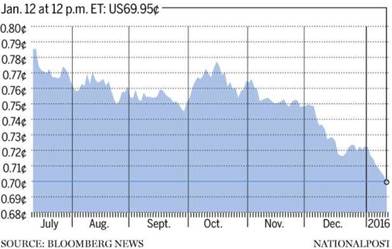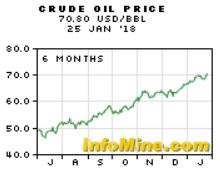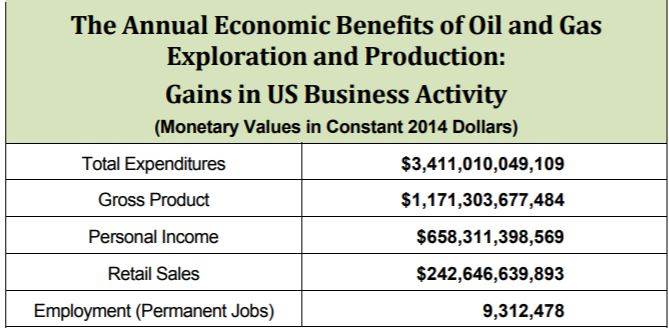Resurgent US Oil Industry Priming the Economic Pump
Commodities / Oil Companies Jan 27, 2018 - 05:47 AM GMTBy: Richard_Mills
 Crude oil prices dropped from $110 a barrel in the summer of 2014 to about $30 in January 2016. The effect on oil producers and oil-producing countries was dramatic. The Russian ruble plunged, and the Canadian dollar slipped to below 70 cents US for the first time since 2003, kicking the country into recession and snuffing out the oil boom in Alberta. Many foreign companies operating in the high-cost Canadian oil sands pulled up stakes.
Crude oil prices dropped from $110 a barrel in the summer of 2014 to about $30 in January 2016. The effect on oil producers and oil-producing countries was dramatic. The Russian ruble plunged, and the Canadian dollar slipped to below 70 cents US for the first time since 2003, kicking the country into recession and snuffing out the oil boom in Alberta. Many foreign companies operating in the high-cost Canadian oil sands pulled up stakes.
 One of the hardest hit countries was Venezuela, whose petro-currency crashed, leading to hyperinflation, shortages, protests and violence - a dire situation that continues to this day. Even Saudi Arabia, the world’s number 2 oil producer, had to tap its $602 billion in foreign reserves to help finance its 2016 deficit of $88 billion - almost a quarter of GDP.
One of the hardest hit countries was Venezuela, whose petro-currency crashed, leading to hyperinflation, shortages, protests and violence - a dire situation that continues to this day. Even Saudi Arabia, the world’s number 2 oil producer, had to tap its $602 billion in foreign reserves to help finance its 2016 deficit of $88 billion - almost a quarter of GDP.
In the UK the number of oil and gas companies experiencing financial distress nearly doubled between the end of 2014 and the final quarter of 2015. In the US, 35 oil exploration companies went bankrupt between July 2014 and December 2015, according to Oil & Gas Financial Journal.
While the oil industry has certainly looked bleak the last few years, with environmentalists gleefully predicting the end of it, recently the industry has turned a corner, putting the doubters on the wrong side of the trade. Earlier this month, oil pushed past $70 a barrel for the first time in three years. The US is exporting record amounts of oil following the lifting of the export ban in 2015, and exploration is back, thanks to Donald Trump’s pro-oil agenda. The shale oil revolution that changed the US’s ability to challenge the world’s top energy producers continues unabated, putting the US for the first time in a position to challenge Russia, the top oil producer, for global energy dominance.

How did we get here?
The United States has been pumping oil since the 1800s, when petroleum was discovered in salt wells drilled in Ohio and Kentucky. The search for “black gold” was fuelled by the rising popularity of the automobile which demanded gasoline for its internal combustion engine.
The first commercial oil well was drilled in Titusville, Pennsylvania, where Colonel Edwin Drake struck “rock oil”. An oil rush followed, with oil wells and refineries springing up, along with railroads to ship the refined products to markets across the country. Pennsylvania oil production peaked in 1891, and was later surpassed by Texas and California.
The US led the world in oil production up to the 1930s when large oil fields were discovered in the Middle East. It was then that OPEC formed, and the oil producing cartel soon overtook the States as the dominant player - by 1970 producing 51% or 23.3 million barrels a day.
US involvement in the Vietnam War exploded military spending during the 1960s and that, along with social welfare reforms undertaken by President Lyndon Johnson without raising taxes, meant the US was running massive balance of payments deficits with the rest of the world.
As a result, in the 1970s the US dollar then went through a massive devaluation, and oil played a crucial role in propping it back up. President Nixon negotiated a deal with Saudi Arabia whereby in exchange for arms and protection, the Saudis would denominate all future sales of oil in US dollars. Other OPEC members agreed to similar deals, ensuring perpetual global demand for greenbacks. The dominance of the US “petrodollar” continues to this day, although as I have recently written, USD hegemony is under threat from China and Russia.
Run-up to $70
On January 11 oil futures for Brent crude, the contract used for over half the world’s oil, rose to over $70 a barrel for the first time since December 2014. Analysts quoted by Bloomberg explained the current oil rally (Brent is still at $70 while WTI, the US benchmark, is hovering around $66) is due to OPEC clearing the glut caused by oversupply of US shale oil. Recall that in November, OPEC members agreed to extend oil output cuts until the end of 2018, something they were loathe to do before then. On January 13 OPEC members Iraq, UAE, Qatar and Oman all joined the chorus, surprisingly, for the cartel to maintain the cuts, despite the temptation to pump more oil to earn $70+ a barrel.
Prices have climbed over 50% since June, helped by cold weather in the US and China raising demand for heating fuel, plus the threat of the Trump Administration reinstating sanctions on Iran, which produces around 3.6 million barrels a day. In the first week of January crude inventories fell to their lowest levels since 2015. The slumping US dollar is also supporting oil prices, along with other commodities.
On Sunday Oilprice.com reported that net long bets on WTI and Brent hit over a billion barrels the week of Jan. 8-12, which is good news for US shale drillers who are hedging their production at higher prices.
Higher oil prices good or bad?
Intuitively a rise in oil price is good news for the American economy especially in light of four years of layoffs, bankruptcies and falling revenues for US oil companies. But in fact higher oil prices are a double-edged sword. On the one hand rising prices are inciting US producers to keep pumping. The Energy Information Administration (EIA) forecasts that at this rate, US production is on track to rival both Saudi Arabia and Russia, topping 11 million barrels a day by the end of 2019. But higher output risks putting downward pressure on oil prices.
Hydraulic fracturing technology coupled with horizontal directional drilling that emerged in the 1990s allowed for a huge burst in the extraction of shale oil deposits which up to that point were too expensive to drill. Fracked wells have a shorter life than conventional ones, meaning companies need to keep drilling so they don’t run out of supply. This activity requires labor for drilling crews, truck drivers, mechanics, etc., not to mention ancillary businesses such as hotels, restaurants and car dealerships. When oil prices drop, all of these businesses suffer, as they did in shale oil states like Texas and North Dakota post-2014. Banking and investment sectors which loan money to oil companies and suppliers also get hit when oil prices fall.
The Perryman Group did a study in 2014 that examined the impacts of oil and gas drilling on the US economy. The study found “the total economic benefits of oil and gas exploration and development activity (including multiplier effects) are estimated to include almost $1.2 trillion in gross product each year, as well as more than 9.3 million permanent jobs in the United States. By both measures, this activity represents nearly 7% of the US economy.”

The negatives of high oil prices are equally well known, though, and manifest in increased costs to the manufacturing and transportation industries which rely on oil and gas inputs. As crude prices rise, so do the prices of jet fuel and gasoline, though controversially, gas prices rarely fall in step with slumping crude prices. Conversely, lower oil prices are generally seen to be good for transportation and manufacturing, where decreased costs are passed on to consumers, notes Investopedia.
In another report, FXCM Market Insights observed that 30% of agricultural expenses are energy-related, which impacts the price of food. Oil prices also affect shipping costs and will influence the prices of most raw materials and commodities including metals. In 2014, the study said, oil consumption accounted for nearly 4% of GDP. A 10% increase in the price of oil shrinks US real GDP by 1.4%. Increases in crude oil prices also push up core inflation and inflation-adjusted bond yields.
The shale revolution
Booming shale production has put the United States oil industry in a position to overtake Russia as the world’s global oil superpower. The growth in shale oil has truly been astounding. As fracking technologies evolved to successfully inject sand, water and chemicals at high pressure to crack tightly formed shale rock formations, thus allowing oil and gas to flow to surface via horizontal and vertical wells, drilling companies flocked to formations like the Bakken, Eagle Ford and Permian Basin. The number of rigs in North Dakota doubled from May to December 2009, and doubled again by the end of 2010. The sleepy town of Williston, North Dakota more than doubled in population from just under 15,000 in 2010 to 32,000. Thousands of workers were housed in makeshift camps while others showed up on spec without any place to live, the FT recounted in a good summary of the shale revolution.
Between 2008 and mid-2017, US oil production nearly doubled to 9.35 million barrels a day, driven largely by production from shale-producing regions. North American shale oil fields caused an estimated 5% increase in US crude production in 2017. Blame for the oil crash of 2014 at least partly rests on the United States for flooding the global market with shale oil.
While OPEC has cut back to compensate, there are no signs that the US is going to do the same. While the first week of 2018 saw production slip from 9.78 million bpd to 9.49 million bpd, by January 19 it was up again to 9.75 million bpd.
According to the EIA, US oil output will average 10.3 million bpd this year and 10.9 million in 2019, driven by growth in Texas and North Dakota shale production. The last time US oil production was this high was in 1970 (9.6 mbpd). Russia, the largest oil producer, by contrast pumped 11 million barrels a day in 2017 while Saudi Arabia, OPEC’s biggest producer, pumped just under 10 million bopd in December, according to numbers reported recently by Bloomberg.
The EIA forecasts US shale production will grow by 111,000 barrels a day to 6.55 million in February; output from the Permian Basin in Texas and New Mexico is seen rising by 76,000 barrels a day.
The economic and political impacts of soaring U.S. output are breathtaking, cutting the nation’s oil imports by a fifth over a decade, providing high-paying jobs in rural communities and lowering consumer prices for domestic gasoline by 37 percent from a 2008 peak.
The news outlet adds that efficiencies brought on by the battle with OPEC including multi-pad drilling and “walking oil rigs” helped US firms to produce enough oil to lobby the government to remove the ban on oil exports that had been in place since 1975 - following the 1973 OPEC oil embargo that led to shortages and long lineups at gas pumps.
Now the US exports some 1.7 million barrels a day of crude and 3.8 billion cubic feet per day of natural gas - spurring a conversion of import to export terminals and a boom in US pipeline construction such as the Keystone XL expansion.
According to Business Insider, with US oil production hitting record levels, refiners from around the world, particularly China, are scrambling to book shipments.
“U.S. crude exports have spiked, jumping from around half a million barrels per day in 2016 and about 1 mb/d for much of 2017, to over 2 mb/d at the end of October, an all-time high,” BI reported.
Offshore oil exploration re-opened
With so much oil being pumped from US fields, is there a risk of running short of reserves? Not as long as Donald Trump stays in power. The pro-coal, pro-oil President has just proposed a sweeping offshore drilling plan - one that is starkly at odds with his predecessor, Barack Obama, who used his final weeks in office to ban oil and gas drilling in portions of the Arctic and Atlantic oceans.
The plan would reverse that ban and open up drilling in those same oceans, as well as parts of the Gulf of Mexico that have been off limits. It would run from 2019 to 2024 and make over 90% of the US coast available for lease sales to oil and gas companies.
The Administration believes the proposed territory holds some 90 billion barrels of oil and 319 trillion cubic feet of natural gas, or reserves that are about 80 percent larger than are currently available, reported Oilprice.com.
“We want to grow our nation’s offshore energy industry, instead of slowly surrendering it to foreign shores,” Ryan Zinke, the Secretary of the Interior, told reporters. “This is a clear difference between energy weakness and energy dominance. Under President Trump we’re going to have the strongest energy policies and be the strongest energy superpower.”
New US conventional oil could also come into play under Trump’s aggressive new exploration policy. Just over a year ago Spanish company Repsol said it has discovered an oil reserve of 1.2 billion barrels in the North Slope of Alaska. CNBC reported the company saying it’s the largest onshore discovery in the US in three decades - allowing production of 120,000 barrels a day starting in 2021.
Conclusion
While the United States remains dependent on foreign countries for a large number of strategic minerals including manganese, cobalt and rare earths, when it comes to oil the States has achieved a remarkable position of energy independence that would have been unthinkable a decade ago. According to the EIA, in 2016 US net imports (imports minus exports) of petroleum from foreign countries was only about a quarter of that consumed in the US - the lowest level since 1970.
The flood of US shale oil has had a major effect on the global supply, so much so that OPEC, which used to hold the balance of oil power, now fears the US oil machine will continue to grind on, knocking the price down and putting pressure on their petroleum-dependent economies.
But we also know that lower oil prices benefit the US economy through lower transportation and manufacturing costs, which through the multiplier effect means lower prices for consumer goods and more spending. Far from collapsing the US oil industry, the oil crash of 2014 only appears to have made it stronger. I’ve got the resurgence of US oil and the investment opportunities it could present on my radar screen. Do you?
If not, maybe it should be.
By Richard (Rick) Mills
If you're interested in learning more about the junior resource and bio-med sectors please come and visit us at www.aheadoftheherd.com
Site membership is free. No credit card or personal information is asked for.
Richard is host of Aheadoftheherd.com and invests in the junior resource sector.
His articles have been published on over 400 websites, including: Wall Street Journal, Market Oracle, USAToday, National Post, Stockhouse, Lewrockwell, Pinnacledigest, Uranium Miner, Beforeitsnews, SeekingAlpha, MontrealGazette, Casey Research, 24hgold, Vancouver Sun, CBSnews, SilverBearCafe, Infomine, Huffington Post, Mineweb, 321Gold, Kitco, Gold-Eagle, The Gold/Energy Reports, Calgary Herald, Resource Investor, Mining.com, Forbes, FNArena, Uraniumseek, Financial Sense, Goldseek, Dallasnews, Vantagewire, Resourceclips and the Association of Mining Analysts.
Copyright © 2018 Richard (Rick) Mills - All Rights Reserved
Legal Notice / Disclaimer: This document is not and should not be construed as an offer to sell or the solicitation of an offer to purchase or subscribe for any investment. Richard Mills has based this document on information obtained from sources he believes to be reliable but which has not been independently verified; Richard Mills makes no guarantee, representation or warranty and accepts no responsibility or liability as to its accuracy or completeness. Expressions of opinion are those of Richard Mills only and are subject to change without notice. Richard Mills assumes no warranty, liability or guarantee for the current relevance, correctness or completeness of any information provided within this Report and will not be held liable for the consequence of reliance upon any opinion or statement contained herein or any omission. Furthermore, I, Richard Mills, assume no liability for any direct or indirect loss or damage or, in particular, for lost profit, which you may incur as a result of the use and existence of the information provided within this Report.
© 2005-2022 http://www.MarketOracle.co.uk - The Market Oracle is a FREE Daily Financial Markets Analysis & Forecasting online publication.



